Utilizing Aquifer Hydraulic Parameters to Assess Local and Regional Recharge Potentials for Enhancing Water Allocations in Groundwater-Dependent Areas in De Aar, Northern Cape, South Africa
Abstract
1. Introduction
2. Geology
3. Hydrogeology
4. Materials and Methods
4.1. Description of the Study Area Location
4.2. Data Collection for Aquifer Hydraulic Parameter Estimation
4.3. The Conceptual Cross-Section of This Study
4.4. Data Processing, Analysis, and Interpretation
5. Results
6. Discussion
6.1. Aquifer Hydraulic Parameter
6.2. Determining Flow Characteristics Using the Method of Derivative Fitting
6.3. Derivative Plot Analysis of the Drawdown Data
6.4. Determining Local and Regional Recharge Potentials
7. Conceptual Models of Groundwater Processes
8. Conclusions and Recommendations
Author Contributions
Funding
Data Availability Statement
Acknowledgments
Conflicts of Interest
Appendix A. Cooper Jacob’s Analytical Solution (Validation Results)



References
- Heiskanen, A.-S.; Belinskij, A. Handbook on Water Allocation in Transboundary Context; United Nations: New York, NY, USA, 2022. [Google Scholar]
- Rojas, R.; Batelaan, O.; Feyen, L.; Dassargues, A. Assessment of conceptual model uncertainty for the regional aquifer Pampa del Tamarugal-North Chile. Hydrol. Earth Syst. Sci. 2010, 14, 171–192. [Google Scholar] [CrossRef]
- Sami, K.; Hughes, D.A. A comparison of recharge estimates to a fractured sedimentary aquifer in South Africa from a chloride mass balance and an integrated surface-subsurface model. J. Hydrol. 1996, 179, 111–136. [Google Scholar] [CrossRef]
- Wolny, F.; Marciniak, M.; Kaczmarek, M. Une méthode pour l’estimation de doubles transmissivités à partir de tests d’infiltration (slug tests). Hydrogeol. J. 2018, 26, 407–416. [Google Scholar] [CrossRef]
- Williams, S.E. Water Allocation for Productive Use: Policy and Implementation. A Case Study of Black Emerging Farmers in the Breede-Gouritz Water Management Area, Western Cape; WRC Report 2530/1; Water Research Commission: Pretoria, South Africa, 2018; Available online: https://wrcwebsite.azurewebsites.net/wp-content/uploads/mdocs/25301.pdf (accessed on 1 September 2025).
- Dennis, I.; Witthüsser, K.; Vivier, K.; Dennis, R.; Mavurayi, A. Groundwater Resource Directed Measures; Water Research Commission: Pretoria, South Africa, 2012; Available online: https://www.wrc.org.za/wp-content/uploads/mdocs/TT299-07.pdf (accessed on 1 September 2025).
- Petrone, P.; De Vita, P.; Marsiglia, P.; Allocca, P.; Coda, S.; Cusano, D.; Lepore, D.; Allocca, V. Hydrogeological conceptual model and groundwater recharge of Avella Mts. karst aquifer (southern Italy): A literature review and update. J Hydrol. Reg. Stud. 2024, 54, 101871. [Google Scholar] [CrossRef]
- Walvoord, M.A.; Stonestrom, D.A.; Andraski, B.J.; Striegl, R.G. Constraining the Inferred Paleohydrologic Evolution of a Deep Unsaturated Zone in the Amargosa Desert. Vadose Zone J. 2004, 3, 502–512. [Google Scholar] [CrossRef]
- Karlović, I.; Marković, T.; Vujnović, T.; Larva, O. Development of a hydrogeological conceptual model of the Varaždin alluvial aquifer. Hydrology 2021, 8, 19. [Google Scholar] [CrossRef]
- Betancur, T.V.; Palacio, C.T.A.; Escobar, J.M.F. Conceptual Models in Hydrogeology, Methodology and Results. In Hydrogeology—A Global Perspective; IntechOpen: London, UK, 2012. [Google Scholar]
- Baloyi, L.; Kanyerere, T.; Muchingami, I.; Pienaar, H. Application of Hydrogeophysical Techniques in Delineating Aquifers to Enhancing Recharge Potential Areas in Groundwater-Dependent Systems, Northern Cape, South Africa. Water 2024, 16, 2652. [Google Scholar] [CrossRef]
- Khadri, S.F.R.; Moharir, K. Characterization of aquifer parameter in basaltic hard rock region through pumping test methods: A case study of Man River basin in Akola and Buldhana Districts, Maharashtra, India. Model. Earth Syst. Environ. 2016, 2, 33. [Google Scholar] [CrossRef]
- UN-Water. Blueprint for Acceleration: Sustainable Development Goal 6. Synthesis Report on Water and Sanitation; United Nations: New York, NY, USA, 2018; Available online: https://www.unwater.org/sites/default/files/app/uploads/2018/12/SDG6_SynthesisReport2018_WaterandSanitation_04122018.pdf (accessed on 1 September 2025).
- Abdullahi, M.G. The Application of Vertical Electrical Sounding (VES) for Groundwater Exploration in Tudun Wada, Kano State, Nigeria. J. Geol. Geosci. 2015, 4, 4–6. [Google Scholar] [CrossRef]
- Ali, M.H.; Zaman, M.H.; Biswas, P.; Islam, M.A.; Karim, N.N. Estimating Hydraulic Conductivity, Transmissibility and Specific Yield of Aquifer in Barind Area, Bangladesh Using Pumping Test. Eur. J. Environ. Earth Sci. 2022, 3, 90–96. [Google Scholar] [CrossRef]
- Gomo, M. On the interpretation of multi-well aquifer-pumping tests in confined porous aquifers using the Cooper and Jacob (1946) method. Sustain. Water Resour. Manag. 2019, 5, 935–946. [Google Scholar] [CrossRef]
- Boucher, M.; Favreau, G.; Vouillamoz, J.M.; Nazoumou, Y.; Legchenko, A. Estimating specific yield and transmissivity with magnetic resonance sounding in an unconfined sandstone aquifer (Niger). Hydrogeol. J. 2009, 17, 1805–1815. [Google Scholar] [CrossRef]
- Woodford, A.C. Preliminary Evaluation of Aquifer Tests Conducted in the South Eastern-Burgerville Areas, South East of De Aar. 1989. Available online: https://www.dws.gov.za/ghreport/Home/Download.aspx?Id=2617 (accessed on 1 September 2025).
- Van Tonder, G.J. Manual on Pumping Test Analysis in Fractured-Rock Aquifers: Report Submitted to Water Research Commission; WRC: Pretoria, South Africa, 2002. [Google Scholar]
- Edwin, O.K.; Alemaw, B.F.; Laletsang, K.; Tafesse, N.T. Estimating Hydraulic Properties of Alluvial Sand Aquifer in Motloutse River course. Eastern Botswana. Asian Rev. Environ. Earth Sci. 2017, 4, 28–35. [Google Scholar] [CrossRef]
- Rushton, K.R. Numerical and conceptual models for recharge estimation in arid and semi-arid zones. In Estimation of Natural Groundwater Recharge; Springer: Dordrecht, The Netherlands, 1988; pp. 223–238. [Google Scholar]
- Vegter, J.R. De Aar’s Groundwater Supply—A Digest of the Past and an Outlook for the Future. GH3775; 1992. Available online: https://www.dws.gov.za/ghreport/Home/Download.aspx?Id=2969 (accessed on 25 May 2025).
- Vegter, J.R. Evaluation of an Alluvial Aquifer at Caroluspoort, De Aar, South Africa. GH2828; 1975. Available online: https://www.dws.gov.za/ghreport/Home/Download.aspx?Id=1703 (accessed on 13 March 2025).
- Kruseman, G.P.; Ridder, N.A.D. Analysis and Evaluation of Pumping Test Data; International Institute for Land Reclamation and Improvement: Wageningen, The Netherlands, 2000. [Google Scholar]
- Mofokeng, S.S.I. Groundwater Resource Assessment for Development and Use in Jozini, KwaZulu-Natal. Master’s Thesis, University of the Free State, Bloemfontein, South Africa, 2017. Available online: https://scholar.ufs.ac.za/items/4ba2d91f-a109-4dbd-8c45-2e8c7942e914 (accessed on 1 September 2025).
- Halford, K.J.; Weight, W.D.; Schreiber, R.P. Interpretation of transmissivity estimates from single-well pumping aquifer tests. Ground Water 2006, 44, 467–471. [Google Scholar] [CrossRef]
- Olivier, K.K.J.; Jules, M.O.M.; Parfait, S.A.; Frédéric, P.; Brou, D.; Didier, G. Elaboration of a hydrogeological conceptual model by application of electrical resistivity tomography: Case of the Lobo catchment (Centre-Western Côte d’Ivoire). Sci. Afr. 2022, 16, e01234. [Google Scholar] [CrossRef]
- Falowo, O.O.; Daramola, A.S.; Ojo, O.O. Aquifers Hydraulic Parameters Measurement and Analysis by Pumping Test. Am. J. Water Resour. 2019, 7, 146–154. [Google Scholar]
- Samani, N.; Pasandi, M.; Barry, D.A. Characterizing a heterogeneous aquifer by derivative analysis of pumping and recovery test data. J. Geol. Soc. Iran 2006, 1, 29–41. [Google Scholar]
- Atangana, A. Analytical solutions for the recovery tests after constant-discharge tests in confined aquifers. Water SA 2014, 40, 595–600. [Google Scholar] [CrossRef]
- Bennett, G.; Van Camp, M.; Shemsanga, C.; Kervyn, M.; Walraevens, K. Delineation of the aquifer structure and estimation of hydraulic properties on the flanks of Mount Meru, Northern Tanzania. J. Afr. Earth Sci. 2022, 196, 104673. [Google Scholar] [CrossRef]
- Grobler, R.J. Hydrogeological Exploration and Characterisation of the Aquifers Found in Middelburg, Eastern Cape, for Town Water Supply; University of the Free State: Bloemfontein, South Africa, 2014; Available online: https://scholar.ufs.ac.za/items/14bbe7b9-4c6c-457f-a432-a71fa08b23e8 (accessed on 1 September 2025).
- Abdullahi, I.-N. Estimating Aquifer Hydraulic Properties in Bida Basin, Central Nigeria Using Empirical Methods. Earth Sci. Res. 2013, 2, 209–221. [Google Scholar] [CrossRef]
- Lohman, S.W. Groundwater Hydraulics; US Government Printing Office: Washington, DC, USA, 1972; Volume 708. Available online: https://www.nrc.gov/docs/ML1735/ML17355A590.pdf (accessed on 1 September 2025).
- Michael, H.A.; Voss, C.I. Estimation of regional-scale groundwater flow properties in the Bengal Basin of India and Bangladesh. Hydrogeol. J. 2009, 17, 1329–1346. [Google Scholar] [CrossRef]
- Woessner, W.W.; Eileen, P.P. Hydrogeologic Properties of Earth Materials and Principles of Groundwater Flow; The Groundwater Project: Guelph, ON, Canada, 2020; Available online: https://books.gw-project.org/hydrogeologic-properties-of-earth-materials-and-principles-of-groundwater-flow/ (accessed on 1 September 2025).
- Veltman, S. Analysis of Borehole Pumping Tests, Petrusburg—Aquifer Parameters; Department of Water Affairs and Forestry (DWAF): Pretoria, South Africa, 2003. [Google Scholar]
- Igwebuike, N.; Muchingami, I.; Kanyerere, T. Application of hydrogeophysics and diagnostic plots in setting up a sustainable managed aquifer recharge scheme, West Coast, South Africa. J. Afr. Earth Sci. 2023, 206, 105039. [Google Scholar] [CrossRef]
- Barker, J.A. A generalized radial flow model for hydraulic tests in fractured rock. Water Resour. Res. 1988, 24, 1796–1804. [Google Scholar] [CrossRef]
- Van Tonder, G.J.; Botha, J.F.; Chiang, W.-H.; Kunstmann, H.; Xu, Y. Estimation of the sustainable yields of boreholes in fractured rock formations. J. Hydrol. 2001, 241, 70–90. [Google Scholar] [CrossRef]
- Spane, F.A., Jr.; Wurstner, S.K. DERIV—A computer program for calculating pressure derivatives for use in hydraulic test analysis. Groundwater 1993, 31, 814–822. [Google Scholar] [CrossRef]
- Van Tonder, G.J. Aquifer Test Interpretation with Special Emphasis on the Drawdown Evaluation for Wells Within Fracture Networks Smaller than the Representative Elementary Volume (REV). Ph.D. Dissertation, University of the Free State, Bloemfontein, South Africa, 2002. Available online: https://scholar.ufs.ac.za/items/3047346f-8a54-4ff9-aa98-cc2c37aa3e63 (accessed on 1 September 2025).
- Botha, J.F. Karoo Aquifers: Their Geology, Geometry and Physical Properties; Water Research Commission: Pretoria, South Africa, 1998; Available online: https://www.wrc.org.za/wp-content/uploads/mdocs/487-1-98.pdf (accessed on 1 September 2025).
- Sun, X.; Xiang, Y.; Shi, Z. Estimating the hydraulic parameters of a confined aquifer based on the response of groundwater levels to seismic Rayleigh waves. Geophys. J. Int. 2018, 213, 919–930. [Google Scholar] [CrossRef]
- Van der Schyff, M.; Kanyerere, T.; Israel, S.; Vermaak, N. Using multiple tracers and geological techniques to determine the connectivity between aquifer systems, West Coast, South Africa. Phys. Chem. Earth Parts A/B/C 2020, 118, 102863. [Google Scholar] [CrossRef]

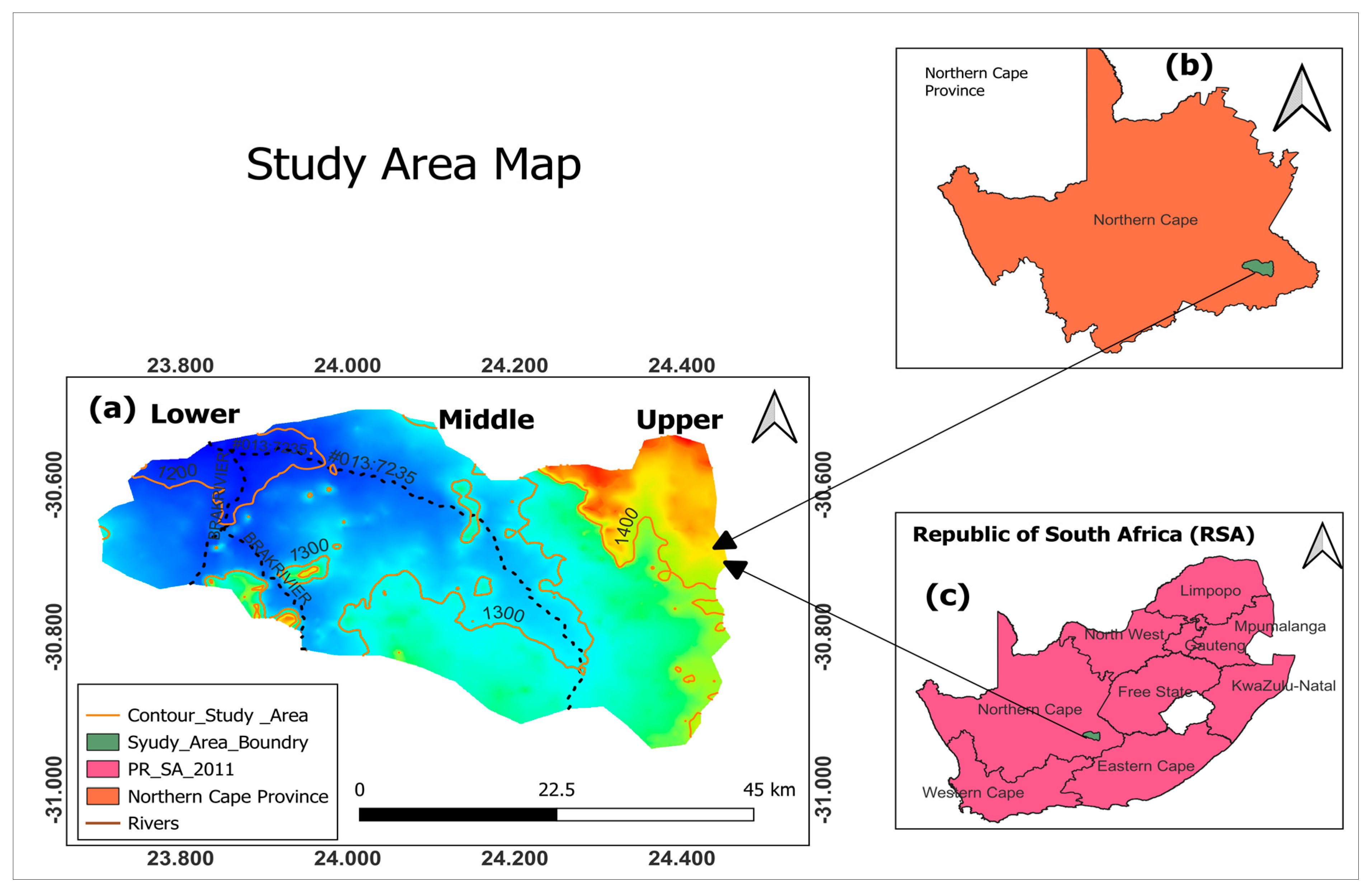
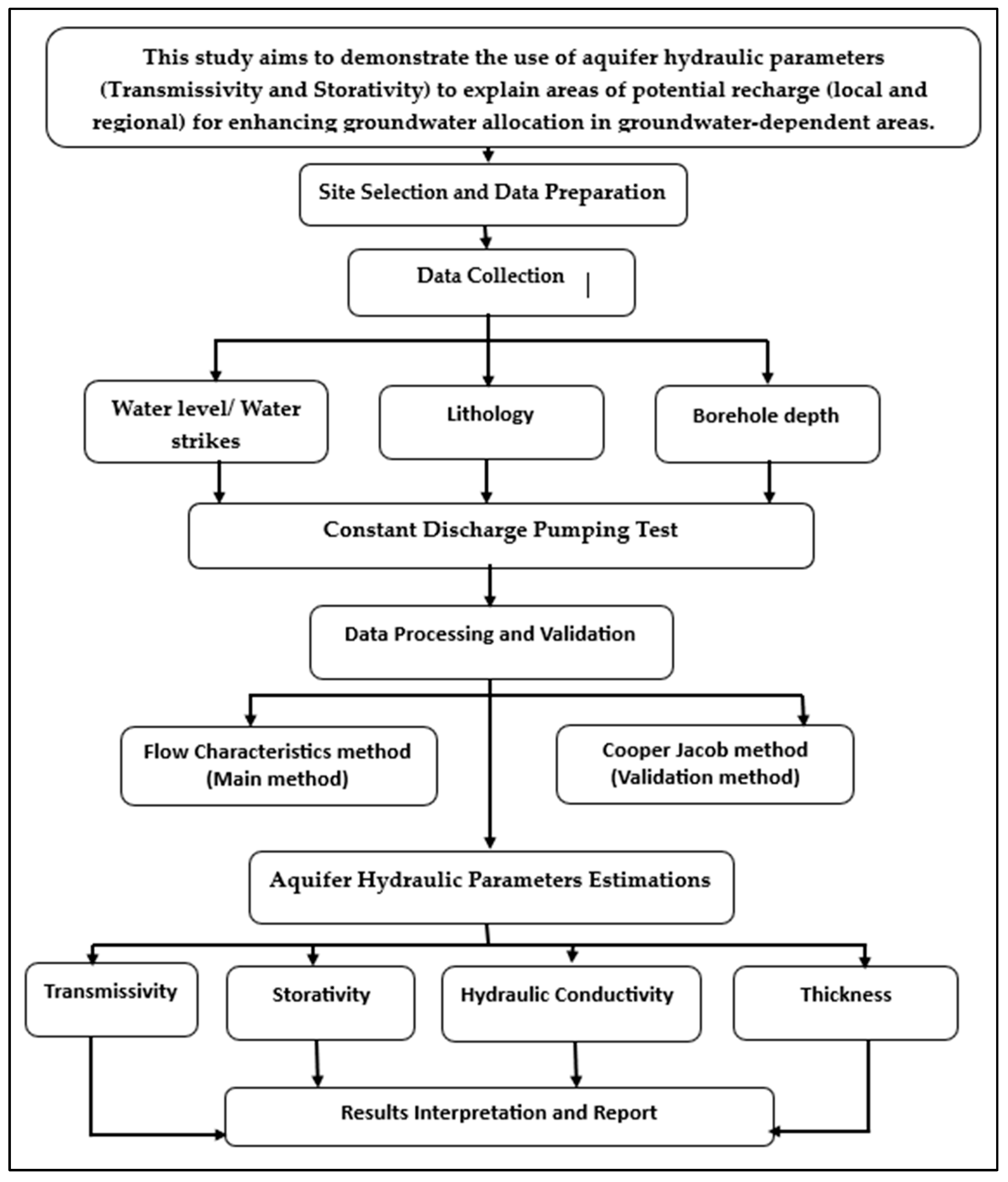
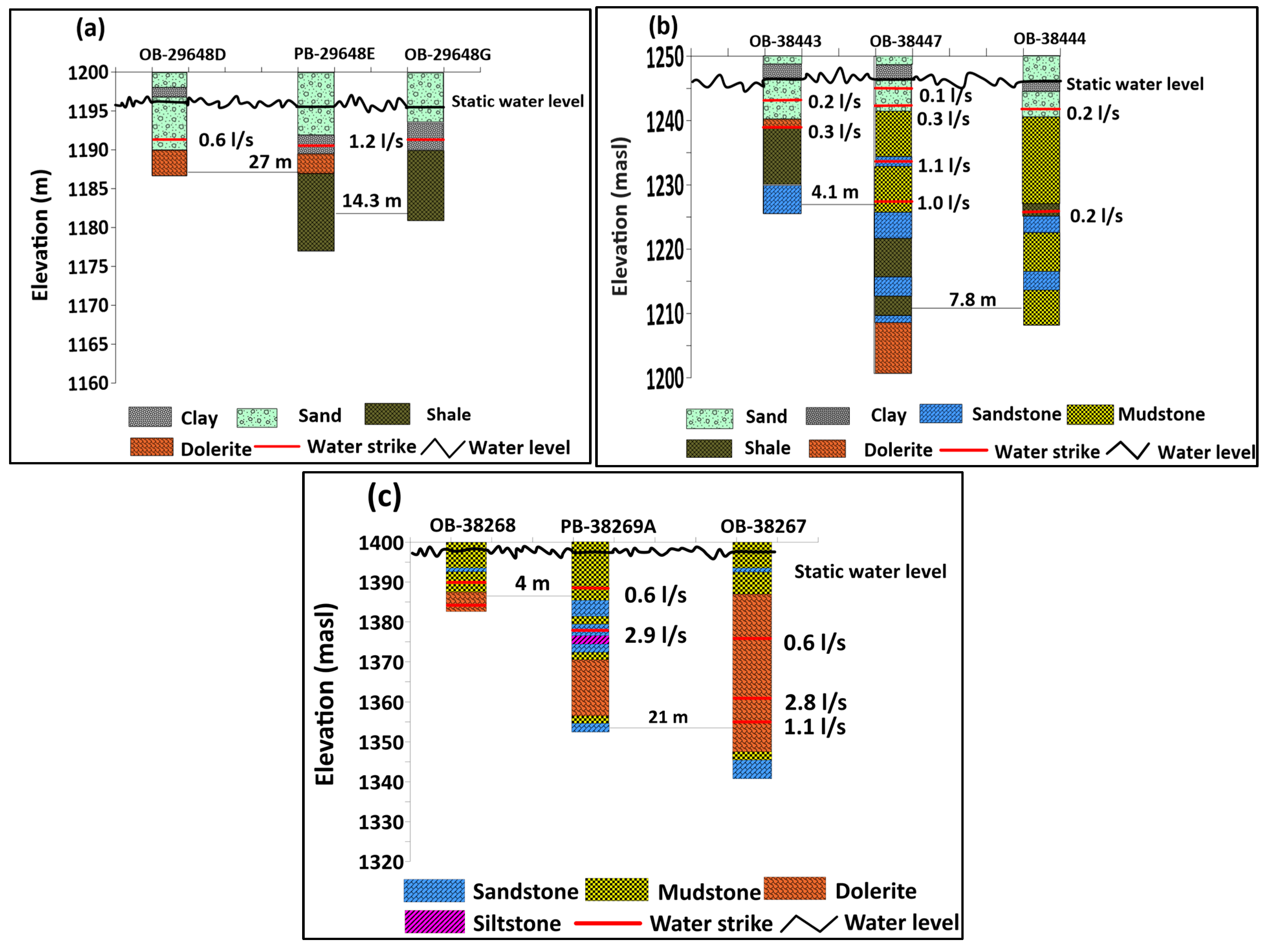
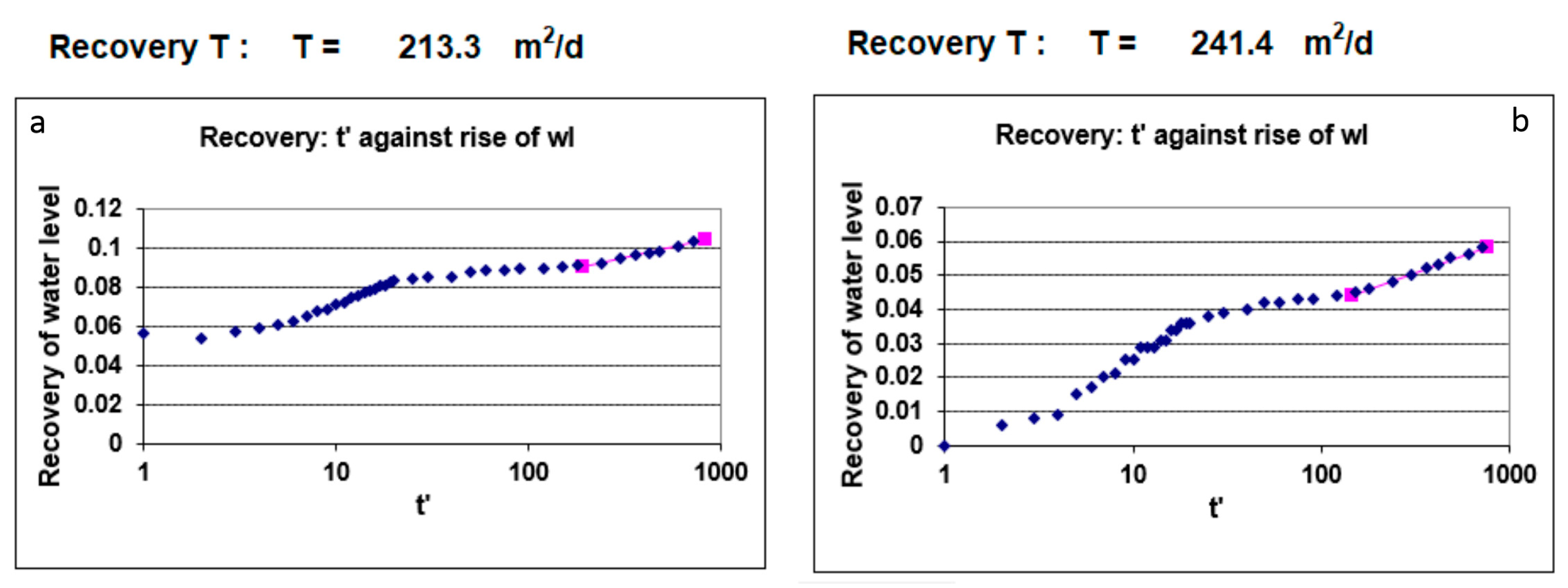
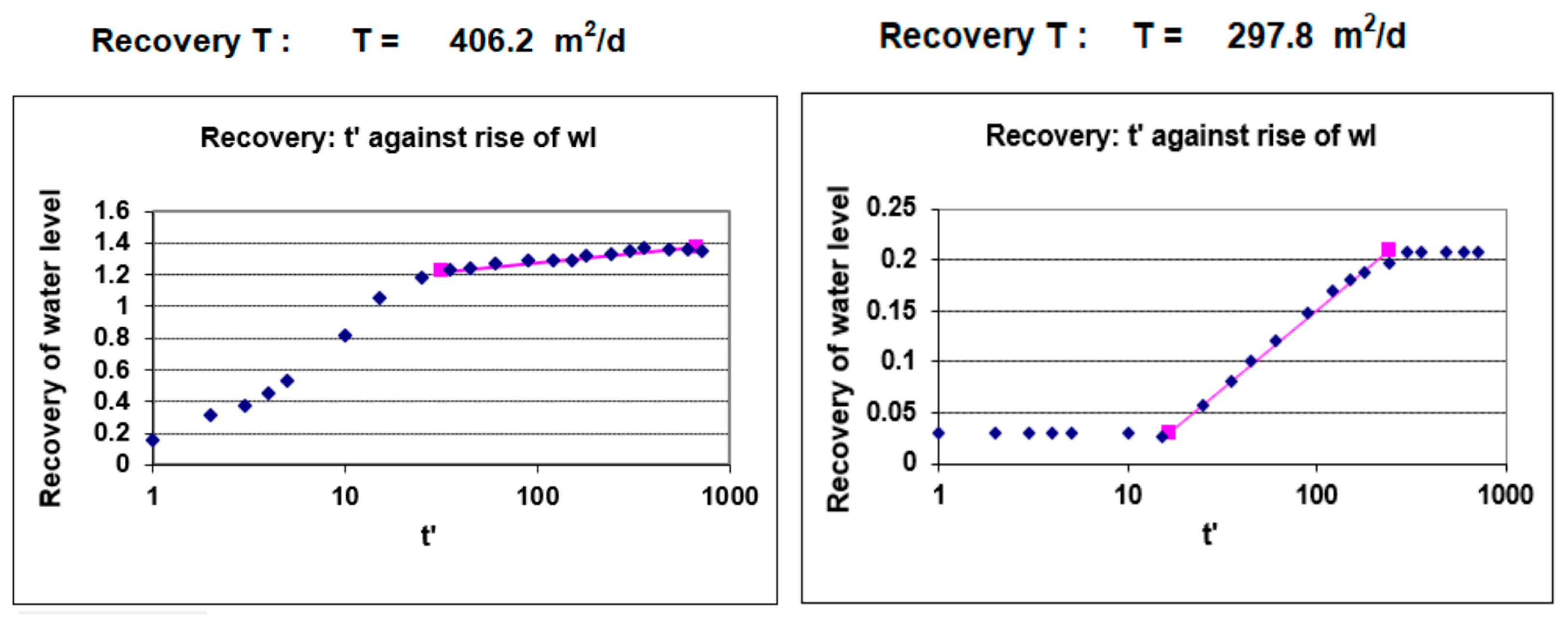
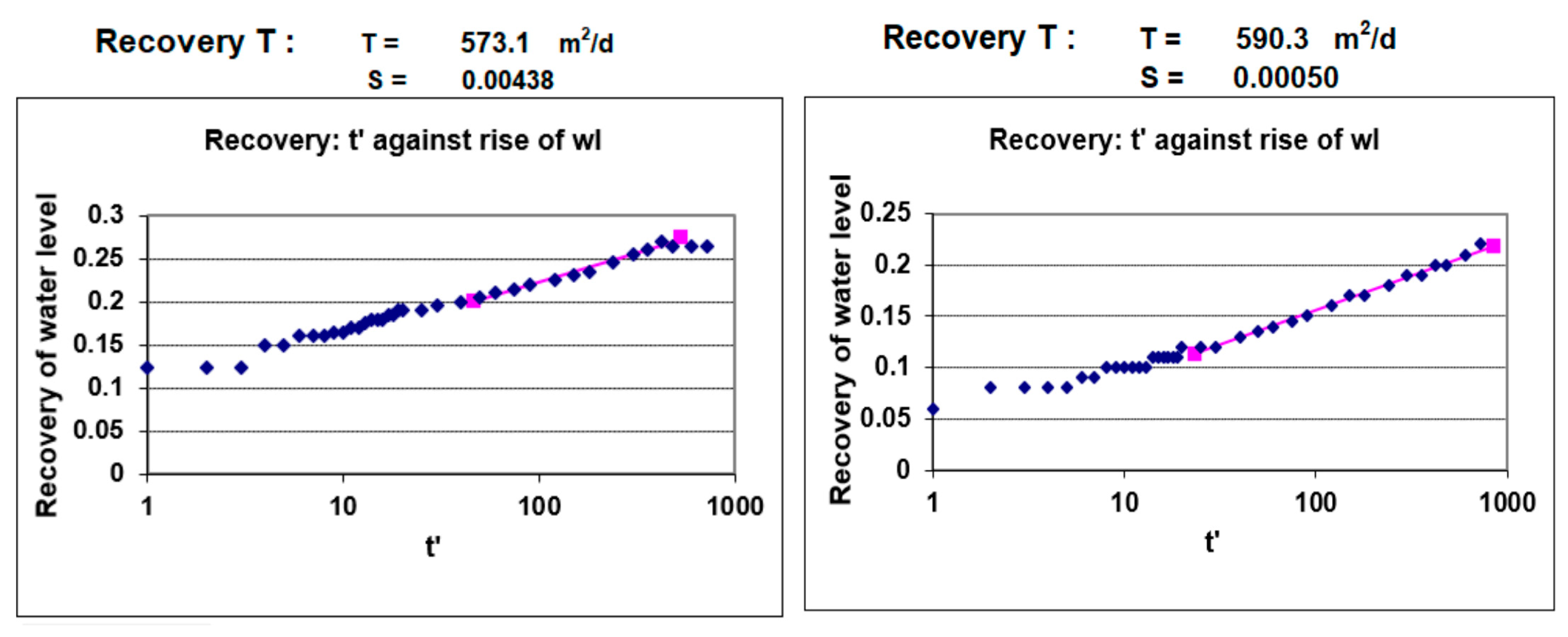
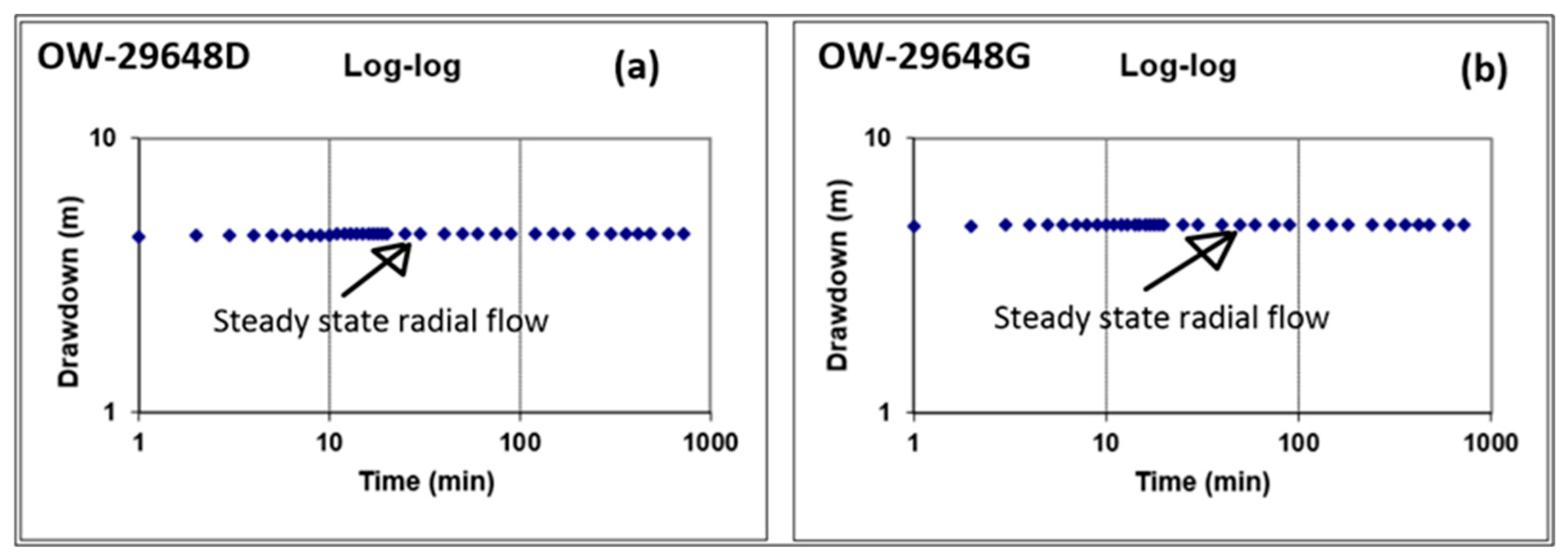
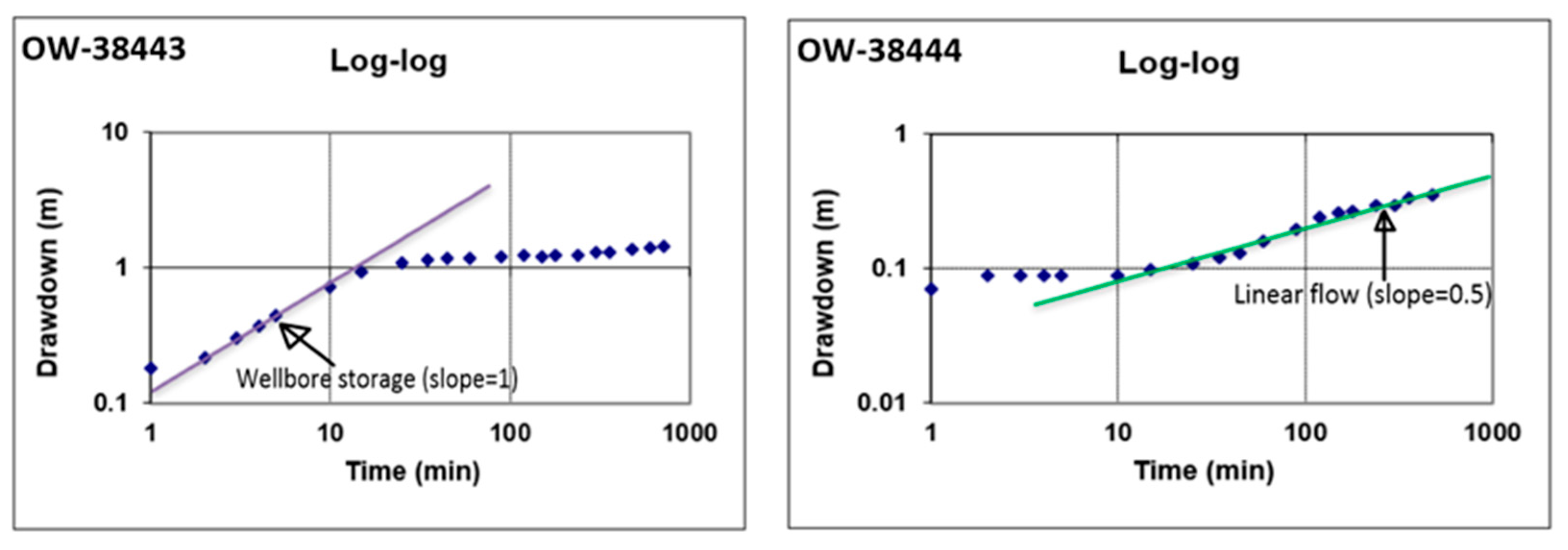
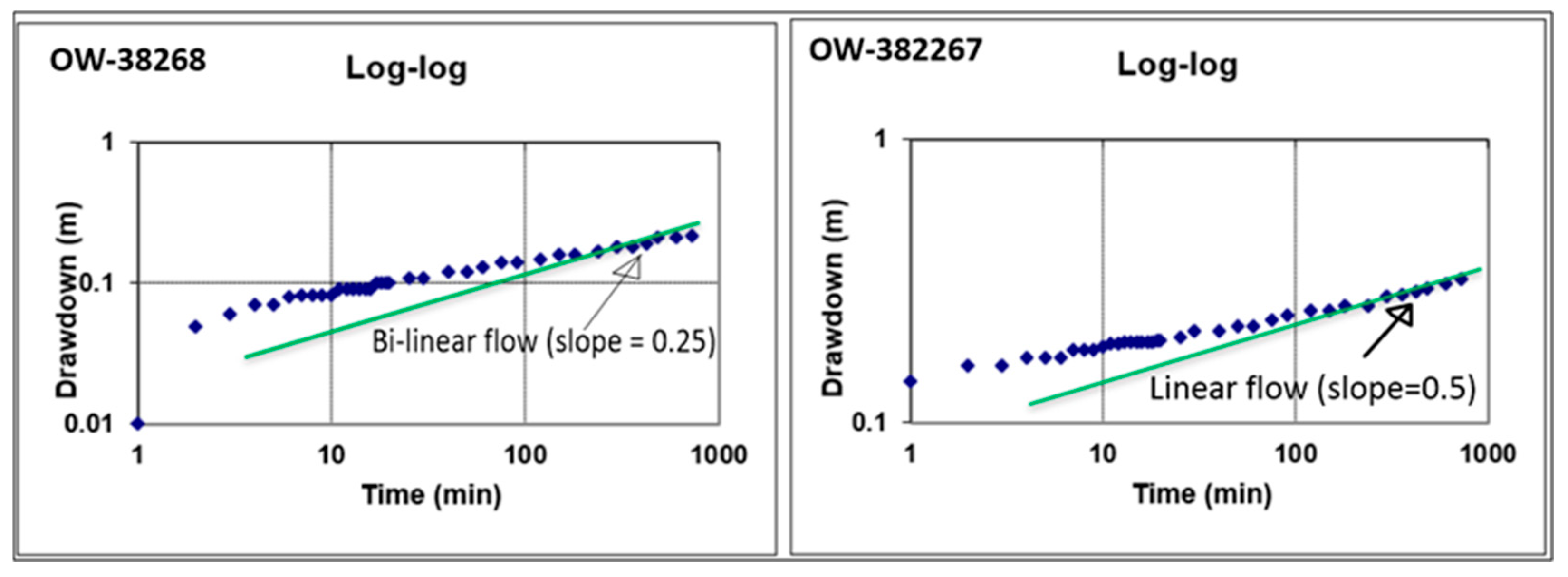

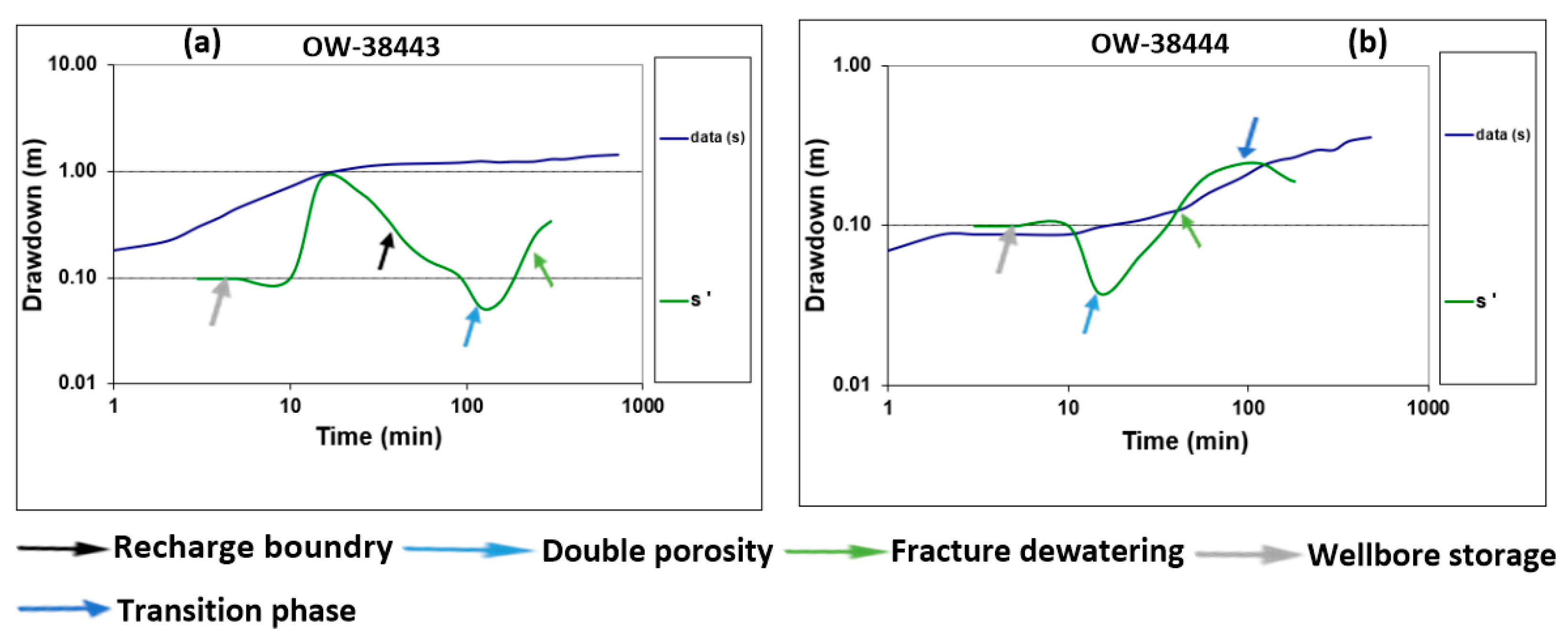

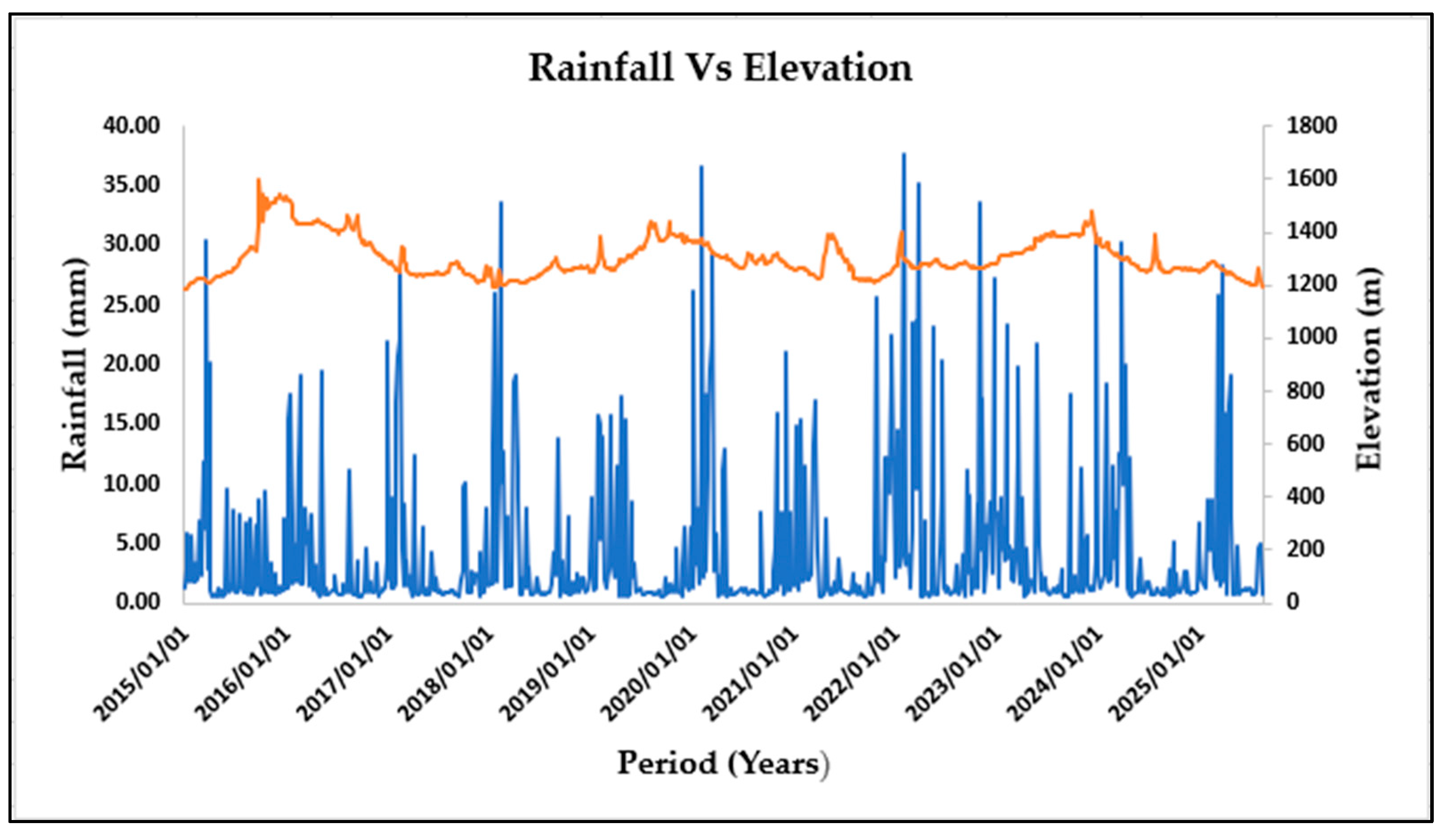
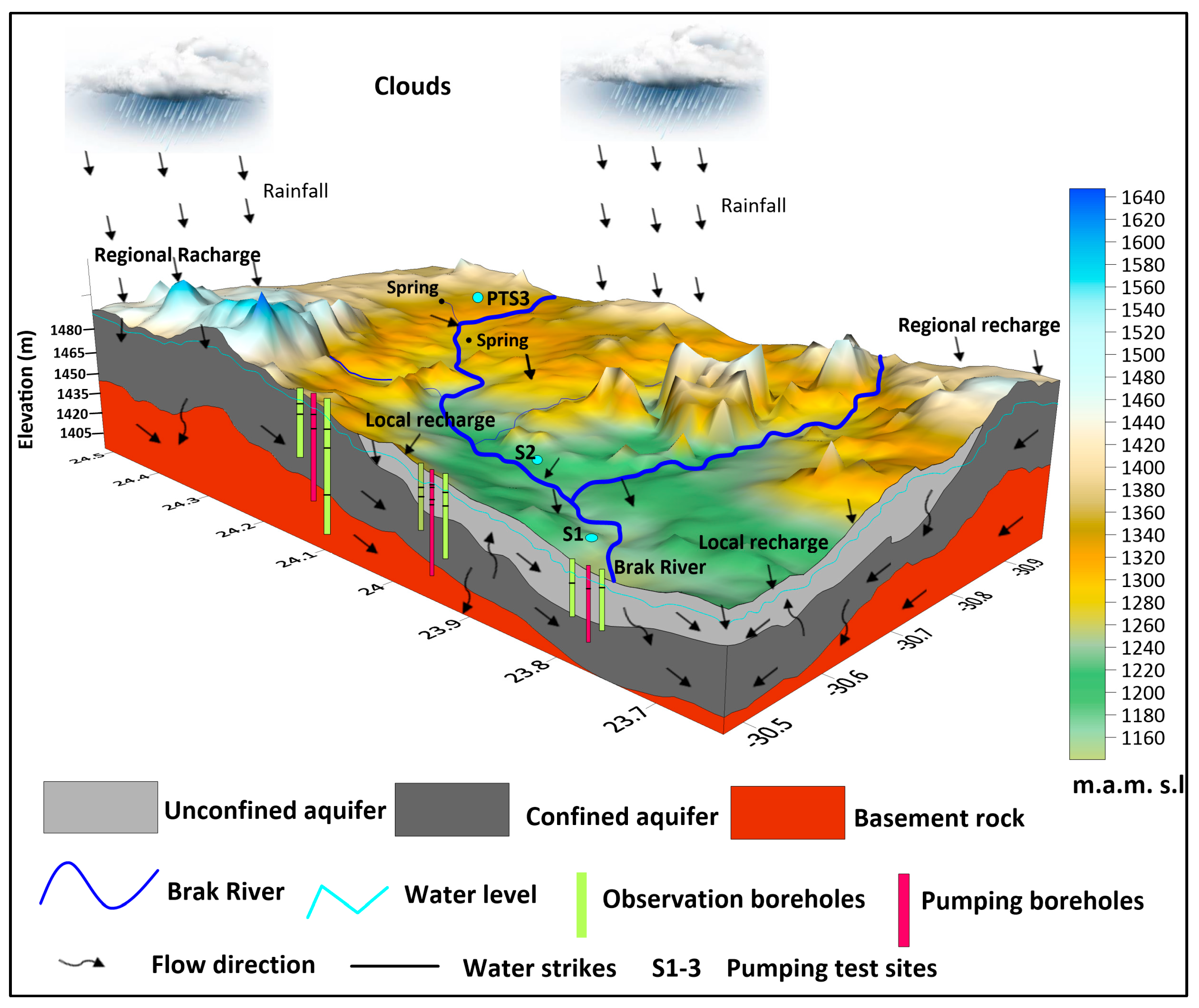
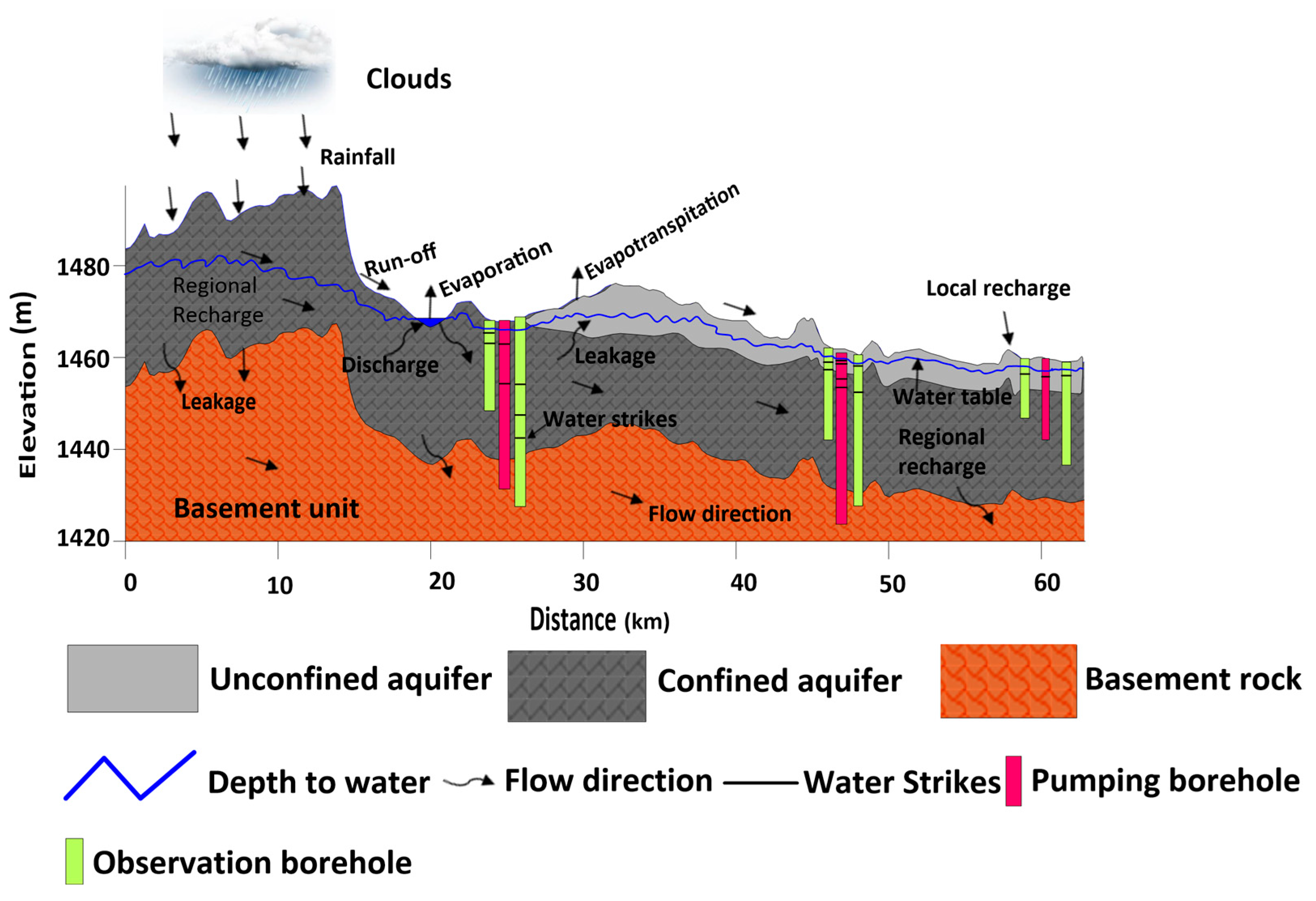
| No | Time Since Start Pumping | Time Intervals |
|---|---|---|
| 1 | 0–20 min | 1 min |
| 2 | 20–30 min | 5 min |
| 3 | 30–60 min | 10 min |
| 4 | 60–90 min | 15 min |
| 5 | 90–180 min | 30 min |
| 6 | 180–480 min | 1 h |
| 7 | 480–720 min | 2 h |
| Lower Catchment | Middle Catchment | Upper Catchment | |||||||
|---|---|---|---|---|---|---|---|---|---|
| Site ID | PB- 29648E | OB-29648D | OB-29648G | PB- 38447 | OB- 38443 | OB- 038444 | PB-38269A | OB- 038267 | OB- 38268 |
| Depth (m) | 24 | 13.5 | 19.5 | 48 | 24 | 42 | 48 | 60 | 18 |
| Distance from P-BH | 0 | 14.3 | 27 | 0 | 4.1 | 7.8 | 0 | 21 | 4 |
| Depth water level (m) | 4.77 | 4.47 | 4.48 | 4.39 | 4.63 | 4.41 | 3.8 | 4.1 | 3.32 |
| Water strike (m) | 9 | 8 | 8 | 5; 8; 17; 24 | 8.5 and 12 | 5.5 and 25 | 12 and 22 | 22; 34; 41 | 5.5 and 12 |
| Pump install depth | 18 | - | - | 30 | - | - | 25 | - | - |
| Pumping rate (L/s) | 0.3 | - | - | 2.5 | - | - | 2.5 | - | - |
| Lithology | Clay | Sand | Clay | Sand clay, Sandstone | Sand clay | Sand clay Shale | Sandstone mudstone | Dolerite | Sandstone Mudstone |
| Total yield (L/s) | 1.2 | 0.6 | 0.6 | 2.5 | 0.5 | 0.4 | 2.5 | 4.5 | - |
| Coordinates | 23.9388 | 23.94361 | 23.9263 | 24.178 | 24.17952 | 24.21455 | 24.36672 | 24.3664 | 24.3663 |
| −30.5505 | −30.5500 | 24.1795 | −30.686 | −30.6886 | −30.6814 | −30.74779 | −30.7471 | −30.7472 | |
| FC Analytical Method | Cooper–Jacob Method | |||||||
|---|---|---|---|---|---|---|---|---|
| Catchment | ID | B (m) | T (m2/day) | K (m/day) | S | T (m2/day) | K (m/day) | S |
| Lower | OB29648D | 9 | 213 | 23 | 0.0000297 | 55 | 6 | 0.00334 |
| OB29648G | 15 | 241 | 16 | 0.0000495 | 195 | 13 | 0.00495 | |
| Middle | OB-38443 | 19 | 487 | 25 | 0.0000627 | 446 | 23 | 0.00131 |
| OB-38444 | 37 | 297 | 8 | 0.000122 | 200 | 5 | 0.0395 | |
| Upper | OB-38268 | 14 | 590 | 42 | 0.0000462 | 563 | 40 | 0.000769 |
| OB-38267 | 56 | 596 | 10 | 0.000185 | 502 | 8 | 0.000759 | |
Disclaimer/Publisher’s Note: The statements, opinions and data contained in all publications are solely those of the individual author(s) and contributor(s) and not of MDPI and/or the editor(s). MDPI and/or the editor(s) disclaim responsibility for any injury to people or property resulting from any ideas, methods, instructions or products referred to in the content. |
© 2025 by the authors. Licensee MDPI, Basel, Switzerland. This article is an open access article distributed under the terms and conditions of the Creative Commons Attribution (CC BY) license (https://creativecommons.org/licenses/by/4.0/).
Share and Cite
Baloyi, L.; Kanyerere, T.; Muchingami, I.; Pienaar, H.; Igwebuike, N.; Mukhawana, M.B. Utilizing Aquifer Hydraulic Parameters to Assess Local and Regional Recharge Potentials for Enhancing Water Allocations in Groundwater-Dependent Areas in De Aar, Northern Cape, South Africa. Water 2025, 17, 2709. https://doi.org/10.3390/w17182709
Baloyi L, Kanyerere T, Muchingami I, Pienaar H, Igwebuike N, Mukhawana MB. Utilizing Aquifer Hydraulic Parameters to Assess Local and Regional Recharge Potentials for Enhancing Water Allocations in Groundwater-Dependent Areas in De Aar, Northern Cape, South Africa. Water. 2025; 17(18):2709. https://doi.org/10.3390/w17182709
Chicago/Turabian StyleBaloyi, Lucky, Thokozani Kanyerere, Innocent Muchingami, Harrison Pienaar, Ndubuisi Igwebuike, and Mxolisi B. Mukhawana. 2025. "Utilizing Aquifer Hydraulic Parameters to Assess Local and Regional Recharge Potentials for Enhancing Water Allocations in Groundwater-Dependent Areas in De Aar, Northern Cape, South Africa" Water 17, no. 18: 2709. https://doi.org/10.3390/w17182709
APA StyleBaloyi, L., Kanyerere, T., Muchingami, I., Pienaar, H., Igwebuike, N., & Mukhawana, M. B. (2025). Utilizing Aquifer Hydraulic Parameters to Assess Local and Regional Recharge Potentials for Enhancing Water Allocations in Groundwater-Dependent Areas in De Aar, Northern Cape, South Africa. Water, 17(18), 2709. https://doi.org/10.3390/w17182709







